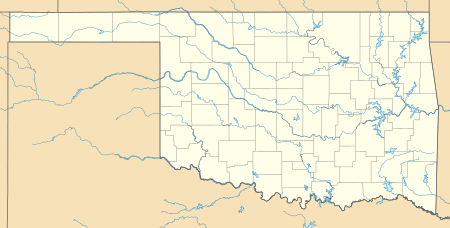Heavener Runestone Park
Heavener Runestone Park is a 55-acre (220,000 m2) park located in Le Flore County, Oklahoma. It is located near the city of Heavener, Oklahoma.[1] Formerly a state park of Oklahoma, it was transferred to the City of Heavener in 2011, and is now operated by the Friends of Heavener Runestone, a non-profit organization. The Festival held at the park on two weekends a year serves as a fundraiser for operating and maintaining the park.
| Heavener Runestone Park | |
|---|---|
 | |
| Location | Le Flore County, Oklahoma, United States |
| Nearest city | Heavener, OK |
| Coordinates | 34.9°N 94.578056°W |
| Area | 55 acres (22 ha) |
| Established | 1970 |
| Governing body | City of Heavener, Oklahoma |
| www | |
Opened in 1970, the park has been erected around the Heavener Runestone, a runestone found in 1923, and most likely inscribed in the 19th century, perhaps by a Swedish immigrant. The stone is located on Poteau Mountain just outside the town's limits.
Transfer from state to city park
The Oklahoma Tourism and Recreation Department announced in March 2011 that it would close the Heavener Runestone State Park on August 15, 2011, due to budget cuts.[2] However, the City of Heavener agreed to assume ownership and operation of the 55-acre park beginning July 1, 2011.[3] The park is now managed by a group of volunteers that make a 501c3 non profit organization.
Park facilities
Heavener Park offers , picnic tables, outdoor grills, primitive campsites with showers available, amphitheater, playground, hiking, exploring, and educational programs about the Runestone. The park also offers the top portion for private use for special events such as weddings, reunions birthdays etc for a fee.
Assessment of the runestone
Henrik Williams, a professor of Scandinavian languages at Uppsala University has studied the Heavener stone, as well as many other such stones elsewhere in the world. He said that the Heavener stone is an impressive runic memorial,[lower-alpha 1] but is unlikely to be as old as some of the local legends claim. He noted that there is no evidence that any Europeans were in this area during the Viking era. He stated that these runes represent the Elder Futhark system that was common during 100 to 700 A. D., which predated the Viking era (750 to 1000 A. D.). Tool marks are still visible on the stone, whereas they should have weathered away if they were created in the Viking era.[4]
Runestone Festival
The park became the site for the annual Heavener Runestone Festival Fundraiser in 2011. It actually occurs on two weekends each year. Features of the event include Celtic and folk music, swordplay, displays of variety of merchant booths, games, a hike to view the runestone, and overnight camping. Cast and Volunteers are all dressed in costume and many attendees dress up as well. The purpose of the festival, besides pure enjoyment, is fundraising to support the park.
Notes
- The rock is 12 feet (3.7 m) by more than 12 feet (3.7 m) wide. Williams said the English translation of the eight runes is GNOMEDAL or GNLOMEDAL, which he interprets as Little Valley.[4]
References
- "Heavener Runestone State Park". Oklahoma Tourism and Recreation Department. Retrieved January 6, 2013.
- Regina Smith (March 5, 2011). "Heavener Runestone State Park Closing Due To Budget Cuts". Poteau Daily News. Archived from the original on July 15, 2011.
- Mary L. Crider (June 11, 2011). "Brushy Lake State Park Transfers To Sallisaw". The Times Record.
- Wallace, Josh. "Oklahoma runestone is impressive but not from Vikings, Swedish scholar says". NewsOK. May 27, 2015. Accessed August 6, 2016.
See also
External links
- Heavener Runestone Park - local tourism information